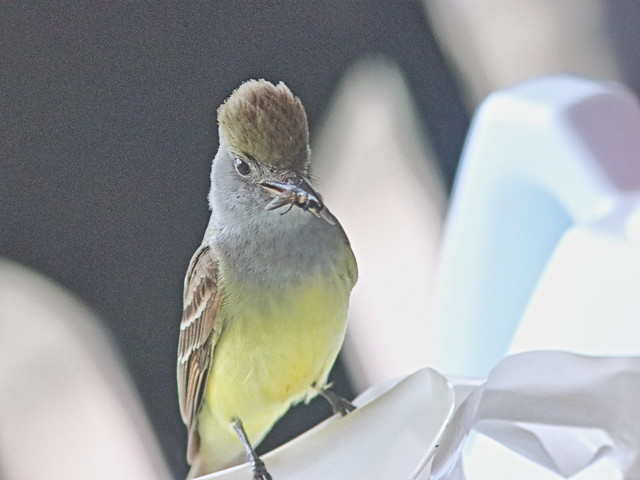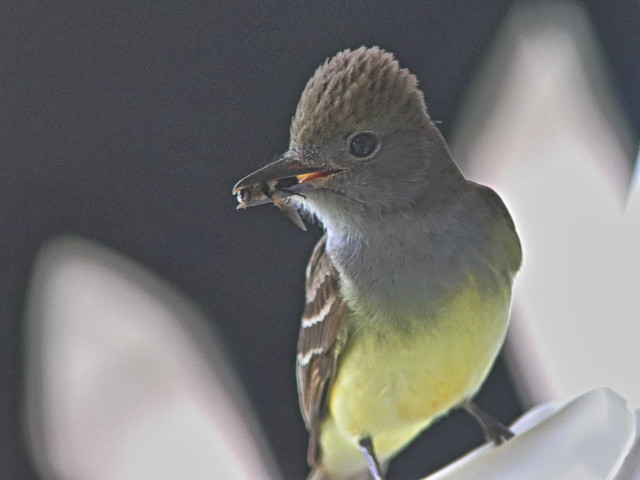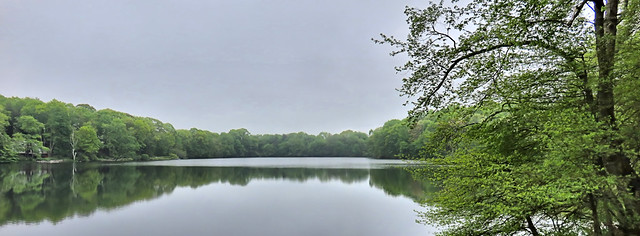The Great Crested Flycatcher is a common summer resident across most of eastern USA into southern Canada. Despite its loud and distinctive calls, it is rather reclusive and hard to find, high in treetops. A large flycatcher, it has a long bill, rusty-red wing and tail feathers and yellow undersides. It is the only flycatcher in the eastern USA which utilizes nest holes.
My best photo of one, until this week, was in Florida, back in 2011:
Here in Connecticut I photographed a pair exploring an exhaust vent with an unprotected opening, high on the rear exterior wall of our residence. We thought that the frequent operation of the fan would discourage them. However, they persisted until it was obvious that they had brought in much nesting material which needed to be removed before replacing the broken cover. It is their habit to rapidly fill any nesting cavity almost to the entry hole and include all manner of trash. If available, shed snake skins are included and may even protrude from the nest hole, possibly effective in deterring predation.*
This week, while tending to the garden directly beneath the opening, our granddaughters heard soft high-pitched calls coming from under the spreading leaves of a daylily. They discovered four newly-hatched chicks of the species.
Returning them to the nest was impossible because the slope of the terrain and lack of an appropriate ladder. Graci, the older of our granddaughters took charge of the situation. She called a local wildlife rehabilitation line and followed their advice, to put the chicks in a cardboard box with a towel and place them as near as possible to the nest, in hopes that the parents would feed them.
Since they were cold she added a sock filled with a cup of dry rice, heated in the microwave for 30 seconds. It was pleasantly warm. The chicks began calling and begging to be fed. Sure enough, the parents came to feed them almost immediately after they were placed in the garden. I took photos from a second floor window:
We were amazed when one of the adults brought in a dragonfly which was almost the same length as the chick:
I was amazed to see the last of the dragonfly disappear into the baby's gullet:
The eyes of the chicks will not open until they are about 5 days old. They normally do not fledge until they are two weeks of age. One of the four was quite listless the entire time and never begged to be fed. The approach of nightfall presented a dilemma. We could not leave the box on the ground for predators to find.
Before dark, after the adult flycatchers had disappeared, we moved them in the box to a table under the covered patio. For extra safety, Graci placed a chair on the table to provide even greater elevation:
She positioned it just outside my bedroom window so that I could keep an eye on it:
We included the warm sock, as the overnight temperature was expected to drop below 60 degrees. It actually dipped to 57°F (13.9°C). Early the next morning I found that the weaker nestling had perished. The other three were cold and nearly unresponsive. Graci brought them inside and after warming them up for a few minutes they began to beg for food. She fed them live mealworms and rather than place them on the ground we decided to see if the parents would return to feed them on the patio.
An adult perched on one of the chairs soon after I exited the patio. I presume it was responding to the calls of the nestlings.
Soon, both adults visited the new location and started bringing in food for the chicks, Light was poor and I was shooting through the windows. They continued feeding and removing excrement throughout the day.
As of this morning, the fourth day since taking charge of the baby flycatchers, all is going well. The three chicks are thriving. Doting parents were waiting for them before sunrise as I brought them out to the patio after spending a second night inside our home. The chicks immediately began calling. Just now, a Gray Squirrel ventured very close to the patio. One of the adult flycatchers attacked the squirrel and appeared to peck its back. The squirrel hastily retreated.
A word of caution. Generally, you should not try to capture a baby bird which appears to have been abandoned by its parents. If able to walk or run it very likely is a fledgling which will be fed periodically by its parents and have survival instincts to protect it for a few days before it takes flight. If it is a younger naked or fluffy nestling it rarely may be possible to return it to the nest if it is accessible and not damaged. Follow Graci's example and call a wildlife rehabilitator for guidance. For more information see: When You Should—and Should Not—Rescue Baby Birds
Sunset over Hartford on June 20:
Morning view of Hartford earlier this week through residual smoke from the Canadian forest fires:
Reflection on the lake
REFERENCE: Birds of the World (The Cornell Lab of Ornithology):
The potential for snakeskin to deter nest predation was first tested experimentally in nest boxes in Florida (KEM); addition of snakeskins to Great Crested Flycatcher nest boxes during Mar-Apr subsequently repelled southern flying squirrels from reoccupying the nest boxes; snakeskins placed in artificial nests in the same nest boxes during Jun reduced the frequency of predation by small mammals. These findings suggest use of snakeskin by the species may be adaptive, at least in this locality where flying squirrels are significant nest predators (Miller 2002, Miller and Leonard 2010). However, some have interpreted this behavior as nothing more than an affinity for shiny and wrinkly items, given that fragments of birch (Betula sp.) bark, onion skins, cellophane, plastic wrappers and other trash are also routinely used in the nest (Whittle 1927b: 263).
This week's header: Sunset over Hartford
= = = = = = = = = = = = = = = =
My Corner of the World
________________________________________________
Please visit the links to all these posts to see some excellent photos on display
________________________________________________
























That was an adventure for all!
ReplyDeleteWhat a great story!
ReplyDeleteI really enjoyed the adventure of caring for the babies. I'm really amazed the parents returned to the box - your skies are always gorgeous. Take care!
ReplyDelete...it's wonderful to know that the mother did not abandon the chicks once that they were out of the nest. Kenneth these are fabulous images, and it's amazing to see how large the insects were compared to the chicks. Thanks.
ReplyDeleteAn educational adventure. Thanks for this post. We have a similar situation with two baby hummingbirds that have fallen out of their nest on our back patio. One didn't make it but hoping the other will.
ReplyDeleteSuch a detailed post about the flycatcher a specie I do not get to see in Australia. There is so much bond between the young and old.
ReplyDeleteWonderful sighting. Good information on flycatchers
ReplyDeleteAwesome cloud patterns.
ReplyDeleteAmazing story of the whole family saving the flycatchers. Your granddaughter was smart to call somebody who knows what they are doing. That's what I would have to do. We get grounded baby birds every now and then and we just leave them alone and I think they do okay.
ReplyDeleteDear Ken, that's an almost unbelievable experience and you did a great job solving it. The photos, especially the one with the dragonfly, are great. Thanks also for the information about the snake skin, I hadn't heard that either. Kind regards - Elke (Nature Thursday)
ReplyDeleteWhat an adventure trying to rescue these baby birds. Well done.
ReplyDeleteHello Ken,
ReplyDeleteWhat a wonderful story and kudos to both you and Graci. I am glad that the parents keep returning to feed their babies too. Awesome photos of the Great-crested Flycatcher and their cute babies. I hope all goes well for the baby flycatchers. Gorgeous sky captures. Thank you for linking up and sharing your post. Take care, have a great weekend. PS, thank you for leaving me a comment.
We saw some of these flycatchers on our hike yesterday. They were almost lemon yellow on their breasts. This sure was a happy story. Thanks for sharing!
ReplyDeletewhat a nice story. Glad the parents accepted the new nest. :) But, how could that little one swallow the entire dragonfly??
ReplyDeleteGreat story! Well done! Glad the parents keep returning to feed their babies. The sky captures are also gorgeous.
ReplyDeleteBless Graci for helping the precious babies!
ReplyDeleteGreat pictures and the rescue story was amazing!
ReplyDeleteWhat a wonderfully inspiring adventure! Kudos to Graci and you.
ReplyDeleteWe have Great Crested Flycatchers nesting in the yard for the second year in a row. Fortunately, no fallen chicks yet!
What lovely photos and enjoyed the info too :-)
ReplyDeleteHave a flycatchertastic week 👍
Fascinating! So glad to see mama taking care of her babies after their fall from the nest.
ReplyDeleteThanks for sharing at http://image-in-ing.blogspot.com/2023/06/it-has-begun.html
That was really fascinating to read; those baby birds sure are lucky your granddaughter spotted them.
ReplyDeleteOMG. THis is so fantastic. What an insight into this. And amazing the parents continued to feed them in the new nest (found them, I mean). This such a great post. Thank you for sharing it with us. Love the rice idea too. #WildbirdWednesday
ReplyDeleteAdorable Flycatchers, Sky shots are marvelous. Thanks for sharing lovely bird photos with Garden Affair.
ReplyDelete